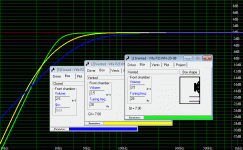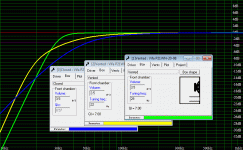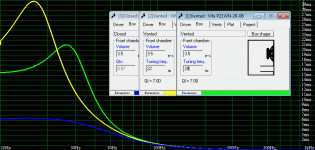hi ...
need help here ... i am interested of ported subwoofer boxes all the time (in fact have build 2 of them) due to their good efficiency (higher output at lower frequencies)...
but so far i am pleased with the output level they produced (very power bass) ... but there is something is missing ... that is good transient response(tight bass for eurodance, techno).
i wonder if for a subwoofer box a larger box then the suggested volume or smaller will give better transient response. Or i can use equalizer to improve the transient response of a ported subwoofer.
In fact, i do have a pair of sealed sattelite speakers which produce nice tight bass although the bass is not heavy.
pls help ... opinions and suggestions are very much welcomed
need help here ... i am interested of ported subwoofer boxes all the time (in fact have build 2 of them) due to their good efficiency (higher output at lower frequencies)...
but so far i am pleased with the output level they produced (very power bass) ... but there is something is missing ... that is good transient response(tight bass for eurodance, techno).
i wonder if for a subwoofer box a larger box then the suggested volume or smaller will give better transient response. Or i can use equalizer to improve the transient response of a ported subwoofer.
In fact, i do have a pair of sealed sattelite speakers which produce nice tight bass although the bass is not heavy.
pls help ... opinions and suggestions are very much welcomed
If your not fixed on bass reflex then there are many other subwoofer options which in general are considered to have more "tight" bass.
Sealed would be the "audiophile" choice, but requires a lot of power and large drivers.
If it's the efficiency you're after than some kind of horn could suit you well. There are many tapped horn designs out there that are quite good, and can be MUCH more efficient than bass reflex. I have built a few negatively tapered horns and been quite happy. I actually have not built a bass reflex sub yet, because all the ones I have heard I felt were too "mushy," so I prefer some kind of horn.
I know this doesn't exactly answer your question but I hope it helps
P.S. "Or i can use equalizer to improve the transient response of a ported subwoofer" I highly doubt there's much you can do with an equalizer for transient response. It could be used to decrease linear distortion (frequency response) but that's about it.
Sealed would be the "audiophile" choice, but requires a lot of power and large drivers.
If it's the efficiency you're after than some kind of horn could suit you well. There are many tapped horn designs out there that are quite good, and can be MUCH more efficient than bass reflex. I have built a few negatively tapered horns and been quite happy. I actually have not built a bass reflex sub yet, because all the ones I have heard I felt were too "mushy," so I prefer some kind of horn.
I know this doesn't exactly answer your question but I hope it helps
P.S. "Or i can use equalizer to improve the transient response of a ported subwoofer" I highly doubt there's much you can do with an equalizer for transient response. It could be used to decrease linear distortion (frequency response) but that's about it.
Last edited:
the fact that you like the "tight bass" from your satellite speakers sorta tells me that you're after more pronounced midbass. How high in frequency are you crossing over your current subwoofers?
If your not fixed on bass reflex then there are many other subwoofer options which in general are considered to have more "tight" bass.
Sealed would be the "audiophile" choice, but requires a lot of power and large drivers.
If it's the efficiency you're after than some kind of horn could suit you well. There are many tapped horn designs out there that are quite good, and can be MUCH more efficient than bass reflex. I have built a few negatively tapered horns and been quite happy. I actually have not built a bass reflex sub yet, because all the ones I have heard I felt were too "mushy," so I prefer some kind of horn.
I know this doesn't exactly answer your question but I hope it helps
P.S. "Or i can use equalizer to improve the transient response of a ported subwoofer" I highly doubt there's much you can do with an equalizer for transient response. It could be used to decrease linear distortion (frequency response) but that's about it.
Everything else being equal, a tapped horn is no more efficient than a vented box IF box size is equal. There's no escape from Hoffmans Iron Law.
tight sound comes mostly from the frequency response. for this really dry sound you want a woofer that does not play much lower than 50hz and has a slightly rising response, so it is louder at 150hz than at 50hz. also, it may not have huge irregularities like bumps in its response. this is easily done with closed boxes since thats about their natural response. with reflex, you need to be attentive that the low end isnt bumped up, making the sound boomy.
you might also try to experiment with proper bass traps and/or nearfield placement of the speakers for the better direct/ambient soundfield ratio.
you might also try to experiment with proper bass traps and/or nearfield placement of the speakers for the better direct/ambient soundfield ratio.
Everything else being equal, a tapped horn is no more efficient than a vented box IF box size is equal. There's no escape from Hoffmans Iron Law.
Up for a little challenge then? The measurements look legit on that one...
Up for a little challenge then? The measurements look legit on that one...
Approximately over 100dB from about 50Hz up using 2.83V into a nominal 8 Ohm load? Box size I estimate to be about 100l net, here's a BR that does about the same thing.

Note that the statement was same efficiency per box size, not per price, as this does have 800€ worth of Italian neo drivers in it (though you might be able to do it cheaper, this was with the second driver I tried for which I already had hornresp inputs, didn't bother optimizing the price.
Last edited:
Hi,
There is a whole range of ported box bass alignments that differ
considerably in the subjective "tightness" of reproduced bass.
Often vented is chosen to optimise f-3dB. Depending on the
driver and box optimising f-6dB to f-10dB can produce
deeper and tighter bass that is subjectively dryer.
Rounding the knee of a vented response improves transient
response. Can be done by port detuning only, or sometimes
a combination of a smaller box and less detuning is useful.
rgds, sreten.
There is a whole range of ported box bass alignments that differ
considerably in the subjective "tightness" of reproduced bass.
Often vented is chosen to optimise f-3dB. Depending on the
driver and box optimising f-6dB to f-10dB can produce
deeper and tighter bass that is subjectively dryer.
Rounding the knee of a vented response improves transient
response. Can be done by port detuning only, or sometimes
a combination of a smaller box and less detuning is useful.
rgds, sreten.
Attachments
Last edited:
@ jwmbro
You must have missed his foot in mouth moment...
You must have missed his foot in mouth moment...
So that's great, but can you do it with a single 12"?Everything else being equal
Port only - much tighter and much deeper, good with room gain :
Attachments
Last edited:
Group delay - note that it is halved down to 30Hz - much tighter .....
Attachments
Last edited:
Hi, That sort of sharp knee in the bass roll off will never sound tight, rgds, sreten.
Group delay - note that it is halved down to 30Hz - much tighter .....
isnt it means that if the subwoofer group delay is lower it will play tighter bass??
Approximately over 100dB from about 50Hz up using 2.83V into a nominal 8 Ohm load? Box size I estimate to be about 100l net, here's a BR that does about the same thing.

Note that the statement was same efficiency per box size, not per price, as this does have 800€ worth of Italian neo drivers in it (though you might be able to do it cheaper, this was with the second driver I tried for which I already had hornresp inputs, didn't bother optimizing the price.
Exactly. Tapped Horns are no more immune from Hoffman's Iron law than BR. If you use a really REALLY large vent with a BR, you can get some crazy efficiency.
isnt it means that if the subwoofer group delay is lower it will play tighter bass??
And how would you arbitrarily lower the group delay without affecting anything else?
And how would you arbitrarily lower the group delay without affecting anything else?
Hi,
You clearly can't. But rounding off the knee of a vented response
does reduce group delay in the main bass range to something
inbetween maximally flat vented and a well damped sealed box.
Room gain, room modes and box placement all come into it.
Often overdamped bass alignments sound tighter, deeper
and flatter than maximally flat, especially for music
rgds, sreten.
another thing ... then how abt 4th order bandpass subwoofer systems... will they give tight bass while with high efficiency ....?
Getting high quality bass involves a lot more than just the common sealed is best non-sense you will hear from everyone.
If you have a set amount of power and will be pushing a sealed system past what it can do or beyond what the amp can do, you will have compressed distortion. A ported system running within its limits and the amp's limits will sound far better than a sealed system that is near its excursion limits and the amp having no headroom left.
Sometimes the ported system will sound much tighter and more accurate.
To answer your original question, ported systems sound best when you are not oversizing the box for more extension. Extended bass shelf alignments have worse group delay and can sound like one note bass.
You cant but people exaggerate the effects.
Using a TC sounds LMSr 12, I started with a 2.1 cubic foot box ported, tuned to 25hz and was pissed off that this was said to be a great sound quality alignment when it sounded pretty bad one note bass. Next I tried 1.7 cubes at 27hz and it sounded considerably better. I ended at 1.4 cubes and 27.5hz for what I couldnt believe was ported. With the different sized boxes and tuning I lost about 2hz in extension but gained a few DB peak at 27hz. The group delay improved quite a bit though.
I tried a sealed alignment too (two of them). It was so power hungry that if you had under 1000watts, the amp limitations alone would make it sound bad.
The gurus will tell you sealed is best but if you dont get the extension you want and have to equalize, it will distort at much lower SPLs, and if your power cant support it, the lack of amp headroom will kill transients. Build to what your requirements are and ignore opinions from those who didnt factually hear what youre looking to work with, power wise and driver wise. Higher QTS drivers will model great ported as far as how deep they go but the added cone weight and higher damping suspension will not sound as tight. Lower QTS drivers ported wont have as good an extension but will sound much tighter subjectively.
If you have a set amount of power and will be pushing a sealed system past what it can do or beyond what the amp can do, you will have compressed distortion. A ported system running within its limits and the amp's limits will sound far better than a sealed system that is near its excursion limits and the amp having no headroom left.
Sometimes the ported system will sound much tighter and more accurate.
To answer your original question, ported systems sound best when you are not oversizing the box for more extension. Extended bass shelf alignments have worse group delay and can sound like one note bass.
And how would you arbitrarily lower the group delay without affecting anything else?
You cant but people exaggerate the effects.
Using a TC sounds LMSr 12, I started with a 2.1 cubic foot box ported, tuned to 25hz and was pissed off that this was said to be a great sound quality alignment when it sounded pretty bad one note bass. Next I tried 1.7 cubes at 27hz and it sounded considerably better. I ended at 1.4 cubes and 27.5hz for what I couldnt believe was ported. With the different sized boxes and tuning I lost about 2hz in extension but gained a few DB peak at 27hz. The group delay improved quite a bit though.
I tried a sealed alignment too (two of them). It was so power hungry that if you had under 1000watts, the amp limitations alone would make it sound bad.
The gurus will tell you sealed is best but if you dont get the extension you want and have to equalize, it will distort at much lower SPLs, and if your power cant support it, the lack of amp headroom will kill transients. Build to what your requirements are and ignore opinions from those who didnt factually hear what youre looking to work with, power wise and driver wise. Higher QTS drivers will model great ported as far as how deep they go but the added cone weight and higher damping suspension will not sound as tight. Lower QTS drivers ported wont have as good an extension but will sound much tighter subjectively.
Last edited:
another thing ... then how abt 4th order bandpass subwoofer systems... will they give tight bass while with high efficiency ....?
Generally speaking a system will exhibit a peak in group delay where the system is resonant, so adding another group delay peak via the band pass port is counter to your goal of "tight" sounding bass.
another thing ... then how abt 4th order bandpass subwoofer systems...
will they give tight bass while with high efficiency ....?
Hi,
4th order bandpass is essentially sealed for the low bass end with
an additional mechanical low pass for its top end, so the question
doesn't make a lot of sense without some qualification.
FWIW most 4th order bandpasses use fairly high Q sealed alignments
for the low end and don't produce tight low bass. They produce high
SPL's around the upper cutoff point, the upper bass, but integration
with satellites is problematical. Not proper HiFi IMHO.
rgds, sreten.
- Home
- Loudspeakers
- Subwoofers
- Building a ported subwoofer with tight bass ... how??


